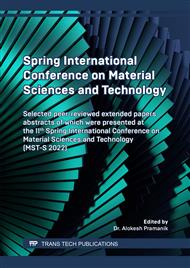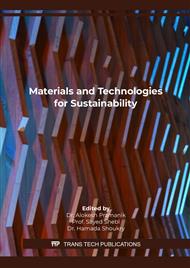[1]
J.T. Burns, J. Boselli. Effect of plate thickness on the environmental fatigue crack growth behavior of AA7085-T7451, Int. J. Fatigue. 2016, 83: 253-268.
DOI: 10.1016/j.ijfatigue.2015.10.020
Google Scholar
[2]
T.R.F. Cavalcante, G.S. Pereira, G.Y. Koga, et al. Fatigue crack propagation of aeronautic AA7050-T7451 and AA2050-T84 aluminum alloys in air and saline environments, Int. J. Fatigue. 2022, 154: 106519.
DOI: 10.1016/j.ijfatigue.2021.106519
Google Scholar
[3]
K.D. Jiang, Z. Zhang, W.B. Zhu, et al. Influence of V additions on microstructures, tensile and fatigue properties of Al–Zn–Mg alloys, Mater. Scie. Eng. A. 2022, 829: 142184.
DOI: 10.1016/j.msea.2021.142184
Google Scholar
[4]
M. Satyanarayana, S. Bathula, A. Kumar. Towards finding an actual fatigue crack growth rate of friction stir processed AA2014 alloy, Mater. Lett. 2021, 305: 130757.
DOI: 10.1016/j.matlet.2021.130757
Google Scholar
[5]
J. Lindigkeit, A. Gysler, G. Lütjering. The effect of microstructure on the fatigue crack propagation behavior of an Al-Zn-Mg-Cu alloy, Metal. Trans. A. 1981, 12(9): 1613-1619.
DOI: 10.1007/bf02643567
Google Scholar
[6]
T.H. Sanders, E.A. Starke. The relationship of microstructure to monotonic and cyclic straining of two age hardening aluminum alloys, Metal. Trans. A. 1976, 7(9): 1407-1418.
DOI: 10.1007/bf02658827
Google Scholar
[7]
S. Zhou, L. Wang, L.Y. Xie, et al. Effect of T7951 secondary aging treatment on crack propagation behavior of 7055 aluminum alloy, Trans. Nonferrous Metals Soc. 2016, 26(4): 938-944.
DOI: 10.1016/s1003-6326(16)64190-0
Google Scholar
[8]
J.T. Burns, V.K. Gupta, S.R. Agnew, et al. Effect of low temperature on fatigue crack formation and microstructure-scale propagation in legacy and modern Al–Zn–Mg–Cu alloys, Int. J. Fatigue. 2013, 55(7): 268-275.
DOI: 10.1016/j.ijfatigue.2013.06.025
Google Scholar
[9]
K. Wen, B. Xiong, Y. Zhang, et al. Measurement and Theoretical Calculation Confirm the Improvement of T7651 Aging State Influenced Precipitation Characteristics on Fatigue Crack Propagation Resistance in an Al–Zn–Mg–Cu Alloy, Met. Mater. Int. 2021, 27: 779-795.
DOI: 10.1007/s12540-019-00446-5
Google Scholar
[10]
H.W. Höppel, L. May, M. Prell, et al. Influence of grain size and precipitation state on the fatigue lives and deformation mechanisms of CP aluminium and AA6082 in the VHCF-regime, Int. J. Fatigue. 2011, 33(1): 10-18.
DOI: 10.1016/j.ijfatigue.2010.04.013
Google Scholar
[11]
Y.L. Wang, Q.L. Pan, L.L. Wei, et al. Effect of retrogression and reaging treatment on the microstructure and fatigue crack growth behavior of 7050 aluminum alloy thick plate, Mater. Des. 2014, 55(6): 857-863.
DOI: 10.1016/j.matdes.2013.09.063
Google Scholar
[12]
Y. Li, G. Xu, S. Liu, et al. Effect of ageing treatment on fatigue crack growth of die forged Al-5.87Zn-2.07Mg-2.42Cu alloy, Eng. Frac. Mech. 2019, 215: 251-260.
DOI: 10.1016/j.engfracmech.2019.04.023
Google Scholar
[13]
R. Yang, Z. Liu, P. Ying, et al. Multistage-aging process effect on formation of GP zones and mechanical properties in Al-Zn-Mg-Cu alloy, Trans. Nonferrous Metals Soc. 2016, 26(5): 1183-1190.
DOI: 10.1016/s1003-6326(16)64221-8
Google Scholar
[14]
P. Xia, Z. Liu, S. Bai, et al. Enhanced fatigue crack propagation resistance in a superhigh strength Al–Zn–Mg–Cu alloy by modifying RRA treatment, Mater. Charact. 2016, 118: 438-445.
DOI: 10.1016/j.matchar.2016.06.023
Google Scholar
[15]
K. Wen, B. Xiong, Y. Zhang, et al. Over-aging influenced matrix precipitate characteristics improve fatigue crack propagation in a Al-Zn-Mg-Cu alloy, Mater. Sci. Eng. A. 2018, 716: 42-54.
DOI: 10.1016/j.msea.2018.01.040
Google Scholar
[16]
J.T. Liu, Y.A. Zhang, X.W. Li, et al. Thermodynamic calculation of high zinc-containing Al-Zn-Mg-Cu alloy, Trans. Nonferrous Metals Soc. 2014, 24(5): 1481-1487.
DOI: 10.1016/s1003-6326(14)63216-7
Google Scholar
[17]
G.E. Pellissier, S.M. Purdy. Stereology and Quantitative Metallography, Addison-Wesley Publishing Company, USA, (1972).
Google Scholar



